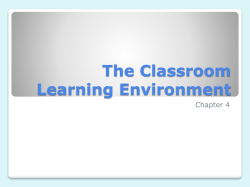
Learning Theory Behaviorism
Learning Theory - Behaviorism PGCE Secondary 2004/5 Behaviorists vs Cognitists Behaviourist (connectionist) – Cognitive theorists Behaviourists treat learning as a matter of links between stimulus and response. Indiv. develops certain responses to given stimuli which the connectionist is interested in observing w.r.t. the ways that experience and other stimuli affect/change them Inferences made from direct observation of effects of In/Output variables applied to animal and human situations Behaviorists vs Cognitists Cognitive psychologists place greater store by functioning of brain and postulate internal mental thinking as well as processes including perception, memorizing and cognitive structures which we acquire from experience and which modify of present behaviour Emphasis on our being aware of our surroundings and being flexible in the solutions we adopt Learning Theory Classification Lunzer’s two-way classification of approaches to the study of learning Behaviorist Role of the stimulus Intermediate Cognitist Reactive Watson Thorndyke Hull Locke Intermediate Pavlov Tolman Gestalt psychs. Structural (active) Skinner Lorenz Broadbent Lunzer Piaget Behaviorism Psychological laboratory established by Wundt in Germany, 1879 Turn of Century – Pavlov and Thorndike began detailed studies of how humans / animals behaved in given lab circumstances rather than on relying on introspective beliefs and feelings Behaviorism Watson 1878-1958 S-R connections more likely to be established the more frequently or recently an S-R bond occurs. Learning occurs by trial and error, with unsuccessful approaches unlikely to be repeated Behaviorism Thorndike, 1874-1949 We stamp in effective S-R connections and stamp out unsuccessful responses Dogs in cages, food, trial and error learning T devised laws of learning which he believed applied equally to animals and humans Importance of end effects of response Satisfying outcomes from a response are more likely to lead to response being repeated. S-R connection reinforced whenever satisfying results are apparent T’s Law of Effect – satisfaction serves to strengthen or reinforce S-R bonds Behaviorism T’s contribution to learning theory is his insistence on the use of scientific measurements as a means of examining learning skills and belief that motivation by reward rather than punishment is an effective way of establishing good learning habits Punishment has indirect influence for good by redirecting person towards suitable S-R bonds Contrast with military discipline Behaviorism I.P. Pavlov, 1849-1936 Use of neutral stimulus (tuning fork) to cause a conditioned response Meat Salivation Sound Attention – salivation (unconditional stimulus) (conditional stimulus) (unconditional reflex) conditional response Behaviorism - Pavlov Tuning fork plus food = reinforcement T fork without food leads to lessening of salivation and eventual extinction of S-R link Classical conditioning rooted in reactions of involuntary systems Child, visit to doctor/dentist, pain Little Albert, white rat, loud noise, fear (Watson) Behaviorism - Pavlov Reciprocal inhibition for extinction Pair conditional stimulus with pleasurable stimulus Bribe child who has been conditioned to dislike school to get him/her to attend Complexity issues Extinction, spontaneous recovery, stimulus discrimination, generalisation Behaviorism B.F. Skinner, 1904-1990 Main interest operant conditioning Rats, levers, learning to get food Instrumental or operant conditioning by which rat produces own reinforcement (reward) by converting productive accident into intentional pattern of behaviour Behaviorism - Skinner Issues continuous reinforcement Needed to get the process growing Intermittent reinforcement Increased intervals between rewards TV ads, gambling (intermittent winnings), judicious use of praise, golf! Schedule of reinforcement Planning of rewards – pigeon, fig of 8 Behaviorism - Skinner Conclusions Each step in Learning Process should be short and grow from previous learned behaviour Regular rewards in early stages, all stages carefully controlled by sched of continuous/intermittent reinforcement Reward (feedback) should follow quickly when correct response appears. Motivation enhanced when we are informed of our progress Learner should be given opportunity to discover stimulus discriminations for most likely path to success. Pigeon had to perceive difference between clock and anticlock motion Questions To what extent is the behaviourist approach used today in Schools and other learning institutions When and how Society When and how To what extent should trial and error learning (discovery learning) be encouraged today? Are there links between constructivism and behaviourism? General Discussion References Applied behavioural analysis – Barbara Cyr The trouble with behaviourism – Neil Davies Behaviourism – The early years – Robert Wozniak Skinners defence of behaviourism – Cole, Hammonds & Hartill Use a search engine to get further information on this subject Also used: Child, D.(1981) Psychology and the teacher. Holt Education, 3rd edition, London Other recommended books - any current educational psychology textbook
© Copyright 2025











